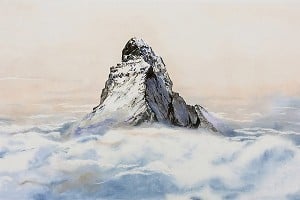
Dan Bailey talks to hyper-real landscape artist Jamie Hageman about his passion for painting the peaks - a self-employed vocation that combines long hours in the studio with the rigours of mountaineering in all seasons.
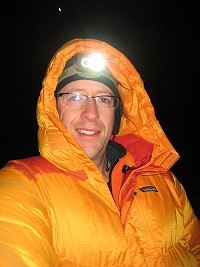
Name Jamie Hageman
Age 33
Based Corpach, nr. Ft.William
Relevant qualifications BA Hons degree in Automotive Design from Coventry University (drawing cars!)
'Salary' Up and down with exhibitions - the pressure's always on
Perks and holidays? Getting out in the mountains all the time is the main perk – it doesn't feel like work. My holidays have always been based around climbing mountains. Last year though I spent a week on a lilo in the South of France - no mountains, and it was great to have a true break from painting. You have to take a step back sometimes, to see the bigger picture and visualise the future of the business.
'I started drawing mountains as a way of 'being there' when I was stuck in East Anglia'
You look like a man in love with the hills. Has this been a lifelong affair?
Growing up on the edge of the Fens in Lincolnshire was perfectly bearable... until I discovered the mountains of North Wales one snowy winter in 1990, courtesy of my Father. After that I would constantly dream of our next summit. But in retrospect Lincolnshire only fuelled my passion for the mountains. I cycled to disused quarries to climb eroded gravel heaps that resembled Crib Goch (in my imagination), visited woodlands picturing them as vast swathes of Caledonian Forest (unfortunately without the distant jagged peaks), built a small 'summit' cairn on the hill at the back of my garden and drew and painted the 3000ft peaks of Snowdonia over and over again. Anything to relieve the yearning. Now I live with the view of Ben Nevis and the Mamores out of my window; it's quite surreal really and I try not to get complacent.
'Winter has always excited me more – the snow and ice giving great contrasts with black rock and deep blue sky, the crispness and clarity'
Most successful painters learned their craft at art school, but you are self-taught. What was your route into mountain painting?
I started drawing the mountains as a way of 'being there' when I was stuck in East Anglia. I eventually moved up to Glen Coe in 2002 to work at the Clachaig Inn as a way of supporting myself while pursuing my true passion for the outdoors, rather than a sensible career in automotive design - which I have a degree in.
How did your painting career to take off?
After I sold a big painting of Sgurr Alasdair to the Dundee Mountain Film Festival for their poster in 2002 I started to paint more and more and began to go out into the mountains with the specific aim of getting ideas for new paintings. This was ideal as my painting philosophy has always been "paint the mountains at their most spectacular and beautiful" so finding new and unusual viewpoints was a pleasure and gave a new dimension to my mountaineering. After the Clachaig I worked at the Ice Factor climbing centre in Kinlochleven, always harbouring the idea of going full-time with the art. I entered a national art competition in 2007, the Jolomo Prize for Scottish Landscape Painting, and was shortlisted as one of nine finalists. I didn't win, but the exposure and contacts meant that at the associated exhibition people were clamouring to buy my work and I sold out immediately. Things like that boost your confidence and give you the belief that it is possible to quit your day job and survive. Thanks to my understanding and supportive girlfriend Clare I took the plunge in 2008 and started my own business.
Last year I entered a BBC art competition called 'Show Me The Monet'. Think X Factor meets Dragons Den for the art world. I thought to myself, "what's the worst that can happen?". Well the worst that can happen is that you seize up on national television in a haze of nerves, and the speech that I had learnt word for word with the help and advice of UKC-er Gordon Stainforth failed to materialise. Despite this (and maybe because of it) I was given more air time than anyone else on the programme (result!). When the judges announced I'd won it took a few days for the news to sink in. The televised exhibition at the Royal College of Art was also a nervous affair, and I now know that I have an allergy towards presenter Chris Hollins. Either that or I hate having a TV camera pointed at me.
With their painstaking detail, sharp clarity and attention to light your pictures seem almost more photographic than photographs. If I had to pin down your style I'd say something like hyper-realism with echoes of the romantic; have you always painted in that way?
Yes. Art at school was frustrating as, although complimentary, my teachers would encourage me to adopt an abstract style that I felt was going against my natural instinct to paint the mountains as I see them. I managed to shrug off total brainwashing and continued to develop my tendency towards realism as a painter and not force a style that was alien to me. That's not to say I don't appreciate impressionist work, it's just not how I operate.
'I've had some long cold nights in the tent in the name of researching painting ideas, but all were satisfying and memorable'
How do you go about selling your work? Where do you exhibit?
Thanks to the recognition gained from competitions and events I now exhibit regularly at The Air Gallery and La Galleria in London, as well as keeping it local with shows at Resipole Studios near Strontian. 2009 saw my first big solo show in London, opened by Charles Kennedy MP, and in 2010 I was invited to show a new collection of work at the Kendal Mountain Festival. For the first time my audience was primarily climbers and walkers with the same love of the mountains. I've come to realise though that my work appeals to all sorts of people with different interests and from different backgrounds, but with the same appreciation of mountain beauty. I also sell prints direct to the public on my website.
What do you look for in a potential subject?
Winter has always excited me more – the snow and ice giving great contrasts with black rock and deep blue sky, the crispness and clarity. The challenge of climbing becomes greater, and more than anything the hills are transformed into mountains. I've had some long cold nights in the tent in the name of researching painting ideas, but all were satisfying and memorable and all contributed to the feel of the finished work.
Painting-wise, do you have particular favourite mountains?
Ben Nevis and Stob Ban are my favourite local mountains and I've painted both many times from all sorts of different viewpoints. They have impressive hidden sides which reward exploration with sometimes unexpected and unusual vistas.
What does your field research entail, and how does this end up as a final painting?
Planning ahead by studying maps gives me clues as to where the best views might be. Then I just need weather, conditions and light to be good enough to get the sketchbook out and record what I see with a camera. Sketches always come first – they help compose the painting, work out its format and where the main features and lines will go. Photos then give me a record of colours and areas of detail to work from when I'm back home in the studio. When everything comes together and the vision of a painting begins to form it's very exciting, and all I want to do is get some paint on the canvas. As the image starts to appear in the studio it's like being there again and re-living those past experiences. It's a buzz.
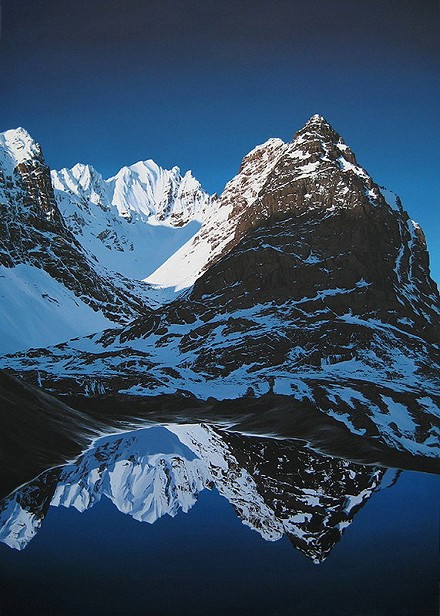
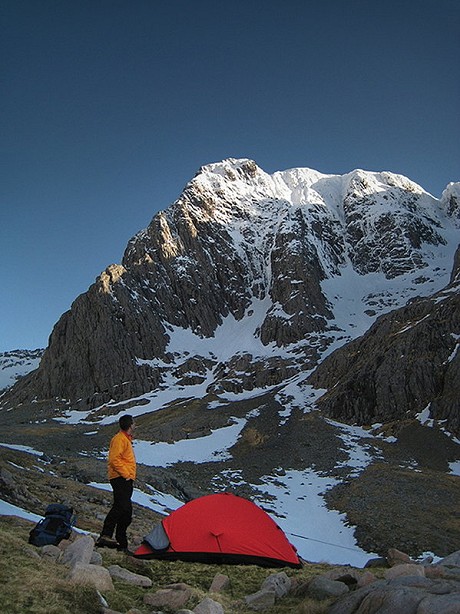
Weather, light and optimal viewpoint – does it take a lot of luck, time, trial and error to get all the elements combined just-so? How does it feel when it finally comes together?
Liathach is a good example. It captured my imagination when I spent three days camping and exploring the shadowy northern flanks. I'd seen Mullach an Rathain from the crest of Am Fasarinen years ago and fell in love with its outline and the wonderful upsweep of its outlier Meall Dearg. I did notice that the potential for an even more beautiful view might present itself from somewhere in Coire na Caime, being lower and so looking up at the mountain rather than along to it. I thought the lochan in the coire might give great reflections (which I wanted to add an extra dimension to the painting) but it was right underneath Meall Dearg, and when I got there I found the peak was foreshortened and had lost some of its impact. As so often happens, the best view is from half-way up, so I climbed the steep flanks of the eastern side of the coire and watched as the scene unfolded. The mountain just got bigger and bigger as I ascended, and the shapes more wild and extreme than I could have imagined. I was far above the lochan now, so was away from those reflections but then I turned around to find a pool of water nestling in a boulder hollow. That was it! I was looking at a view that can only be described as sublime. The jagged black sandstone tiers rising up and up to a deep blue Himalayan-like sky, riven with snow-filled gullies and the final white crest up to the summit looking impossibly high, and all this with a tranquil reflection giving a slightly distorted mirror image – it was perfect. Spine tingling! I didn't care if it rained for the next six months, no-one could take this vision away from me and a trip into the unknown had been successful.
Re-living those moments as I painted was a joy, and although I can spend days working on a small area of detail I know that it'll come together in the end and that patience is rewarded. The buyer asked me for a grid reference for the viewpoint, and is intending to visit the very same spot this summer.
Personally I'd love to see how you might deal with Beinn Dearg Mor, Ladhar Bheinn, the Trotternish ridge, Suilven... or even the stacks of St Kilda. Would you consider any of those worthy subjects? How about bigger more in-your-face mountains abroad?
There's enough in Scotland to keep me busy painting for life. I do travel to foreign mountain ranges and sometimes I paint them too, but the British mountains seem to be unique in their changes of mood and hidden secrets. If I can stand the boat journey St Kilda's towering cliffs and pinnacles might make a fascinating painting (they even get snow on them sometimes). Ladhar Bheinn, the Cuillin, Ben Cruachan, Bidean, Ben Alder, Cairn Toul, even An Sgurr on Eigg – there's plenty of inspiration, and no hurry. I just need the time and the weather.
What are you working on now?
With a winter mantle Sgurr an Fhidhleir and Suilven can take on the appearance of mountains far higher than their 700m heights suggest, and with a bit of artistic licence might even look Himalayan in stature. They're next in line for the 'Jamie Hageman' treatment! Meanwhile signed limited edition prints of my latest metre-wide painting An Teallach Sunrise 2012 (pictured above) will be available later this year.
To see more of Jamie's paintings - or buy a print - visit his website.
More Articles



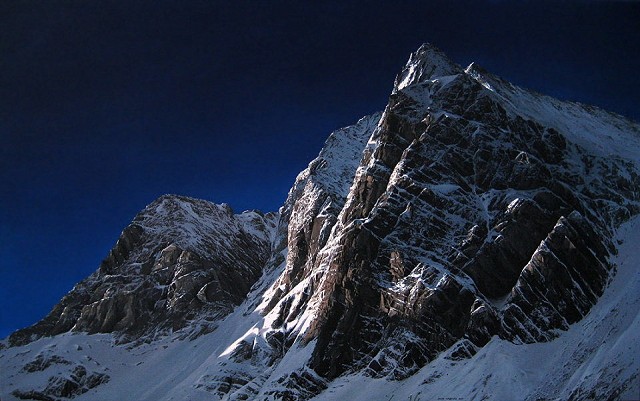

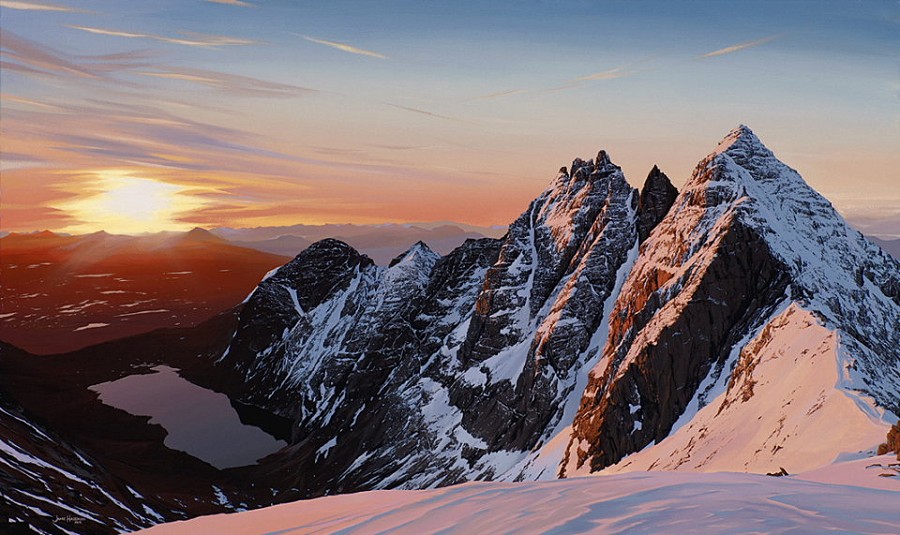

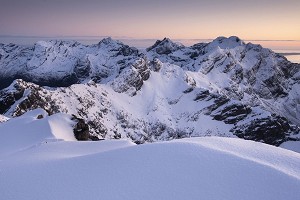
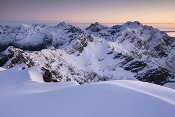
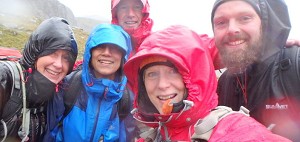





Comments